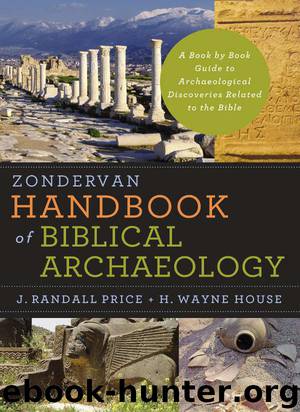Zondervan Handbook of Biblical Archaeology: A Book by Book Guide to Archaeological Discoveries Related to the Bible by Price J. Randall & Price J. Randall & House H. Wayne & House H. Wayne

Author:Price, J. Randall & Price, J. Randall & House, H. Wayne & House, H. Wayne [Price, J. Randall]
Language: eng
Format: azw3
Publisher: Zondervan
Published: 2017-11-27T16:00:00+00:00
8
The Second (Zerubbabel) Temple
Under the headship of Zerubbabel, who became governor of Judah, and Joshua the high priest (Hag 2:2), the foundation for the first phase of the Second Temple was begun by the people. Following the precedent set in preparation for the First Temple, the people contributed generously to the sacred treasury (Ezra 2:68–69). The first act of restoration was the reconstruction of the altar of burnt offering, which permitted the sacrificial system to be reinstituted and the celebration of the biblical festivals to be restored (Ezra 3:1–5). Like the First Temple, Zerubbabel’s Temple was built after the pattern of foreign temples by Phoenician workers (Ezra 3:7–10), in harmony with the decree from the Persian king Darius to rebuild the temple. The Jews who returned from exile were inexperienced and could only build a new temple with the expertise of the Phoenicians. In 538 BC the foundations for the Second Temple were laid; however, the construction of the temple itself met with resistance from Samaritan residents to the north and could not be started again for another fifteen years.
The work was resumed in 520 BC, through the exhortation of the prophets Haggai and Zechariah and a decree from the Persian king Darius, who provided official sanction and support from local taxation to finance the completion of the structure (Ezra 6:1–15). The dedication of this completed structure on March 12, 516/515 BC, some twenty years after the return from exile and exactly seventy years after the desolation of Jerusalem (587/6 BC—a period that had been governed by the state of the temple, see Jer 25:11–12; 29:10; Dan 9:2, 16–17, 24).
The Second Temple was inferior in construction compared to the First Temple, lacking a compound, the two entrance pillars Yachin and Boaz, the two olivewood cherubim that overshadowed the ark, and the ark of the covenant itself. Moreover, while the First Temple had been built at the beginning of Israel’s independent rule, the second was constructed under a time of foreign domination. Most importantly, the visible presence of YHWH was absent from the Second Temple. For these reasons the biblical account notes that many of the priests and Levites who were old enough to have seen the First Temple wept at the time this temple’s foundations were laid (Ezra 3:12–13).
Download
This site does not store any files on its server. We only index and link to content provided by other sites. Please contact the content providers to delete copyright contents if any and email us, we'll remove relevant links or contents immediately.
The Five People You Meet in Heaven by Mitch Albom(3475)
The Secret Power of Speaking God's Word by Joyce Meyer(2975)
Real Sex by Lauren F. Winner(2967)
Name Book, The: Over 10,000 Names--Their Meanings, Origins, and Spiritual Significance by Astoria Dorothy(2940)
The Holy Spirit by Billy Graham(2893)
0041152001443424520 .pdf by Unknown(2784)
ESV Study Bible by Crossway(2732)
How The Mind Works by Steven Pinker(2729)
Ancient Worlds by Michael Scott(2626)
Churchill by Paul Johnson(2506)
The Meaning of the Library by unknow(2505)
The ESV Study Bible by Crossway Bibles(2502)
The Gnostic Gospels by Pagels Elaine(2472)
MOSES THE EGYPTIAN by Jan Assmann(2373)
Jesus by Paul Johnson(2310)
City of Stairs by Robert Jackson Bennett(2309)
The Complete Dead Sea Scrolls in English (7th Edition) (Penguin Classics) by Geza Vermes(2236)
Ancient Near Eastern Thought and the Old Testament by John H. Walton(2196)
The Nativity by Geza Vermes(2180)
